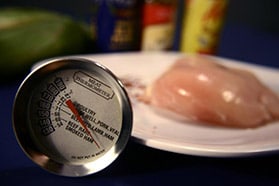How Restaurants Prepare and Cook Chicken
EHS-Net Recommends
Restaurant management and food safety programs should work to improve chicken preparation and cooking. Efforts should focus on creating training and prevention programs that focus on
- Lessening the chances for raw chicken to contaminate other food or equipment.
- Cook chicken to the temperature recommended by FDA (165°F).

Why This Study Was Done
Chicken is commonly linked with foodborne illness, with most of these illnesses coming from Salmonella and Campylobacter germs. Illness linked to chicken can come from cross contamination. This occurs when raw, contaminated chicken touches other foods or kitchen equipment. Illness can also come from cooked chicken not reaching a high enough temperature (165°F) to kill any germs that might be inside it.
We don’t know much about how restaurants prepare and cook chicken. If we learn more, we can improve how restaurants prepare and cook chicken and can lower the number of foodborne illness outbreaks.
What the Study Described
The purpose of this study was to describe how chicken is prepared and cooked in restaurants.
For preparation, we focused on whether restaurants and food workers took steps to stop cross contamination. These steps include
- Washing, rinsing, and sanitizing equipment used with raw chicken.
- Wearing disposable gloves.
- Using separate cutting boards for raw chicken and other foods.
For cooking, we focused on whether
- Managers knew the right cooking temperature for chicken.
- Food workers used thermometers to check the temperatures of cooked chicken.
- Food workers checked thermometers for accuracy.
Study Results
EHS-Net found that many restaurants do not follow the U.S. Food and Drug Administration’s (FDA’s) advice for preparing and cooking chicken.
Preparation
Most managers said their restaurants had a cleaning policy about equipment and surfaces used when preparing raw chicken.
- Most of these policies included the three steps recommended by U.S. Food and Drug Administration (FDA): washing, rinsing, and sanitizing.
- About 1 in 10 managers said they wash and rinse equipment but do not sanitize it.
- About 1 in 3 managers said they wipe equipment with sanitizer but do not wash or rinse it first.
One in four managers said that their workers do not always use gloves while working with raw chicken.
Four in ten managers said that they do not always have cutting boards assigned for use only with raw meat.
Cooking
Less than half of the kitchen managers we talked to
- Knew the temperature to which chicken should be cooked (165°F).
- Said that their food workers use a thermometer to tell when chicken is fully cooked.
In restaurants that use thermometers, about 1 in 3 managers said that their thermometers are checked for accuracy less than once a month.
- Cross contamination: spread of germs from one surface or food to another by contact.
- Disposable: designed to be used once and then thrown away.
- Salmonella and Campylobacter: germs that cause foodborne illness.
- Sanitize: process to clean and disinfect a surface that will come in contact with food; involves using heat and/or chemicals.
Scientific article this plain language summary is based on: Frequency of Inadequate Chicken Cross Contamination Prevention and Cooking Practices in Restaurants. [PDF – 77 KB]
Chicken Handling Practices Study (study information)
More EHS-Net publications by Study Topic
This study was conducted by the Environmental Health Specialists Network (EHS-Net). EHS-Net is a federally funded collaboration of federal, state, and local environmental health specialists and epidemiologists working to better understand the environmental causes of foodborne illness.